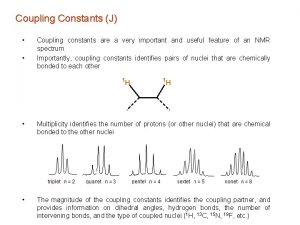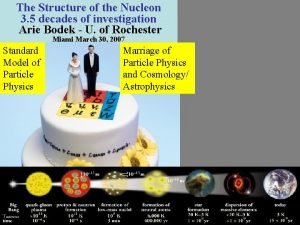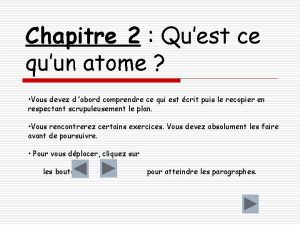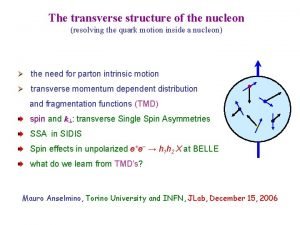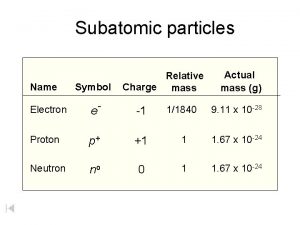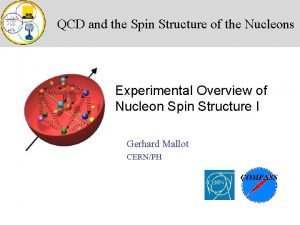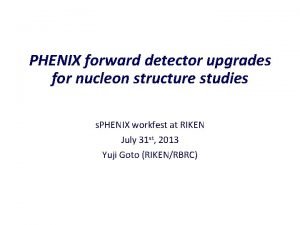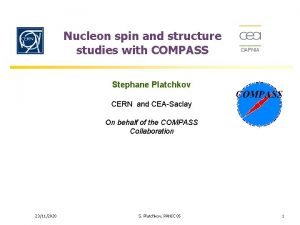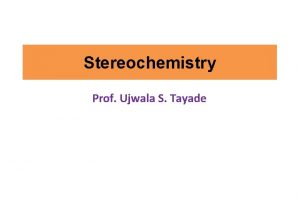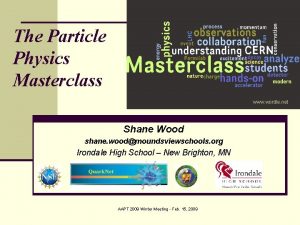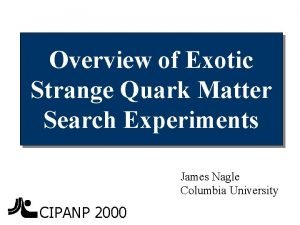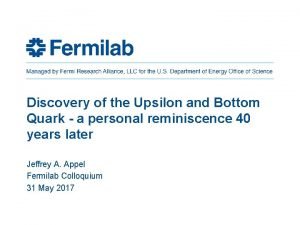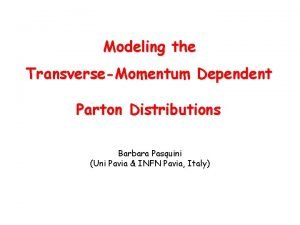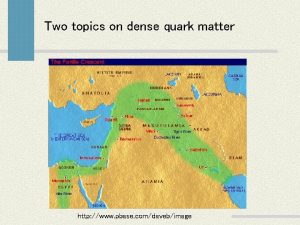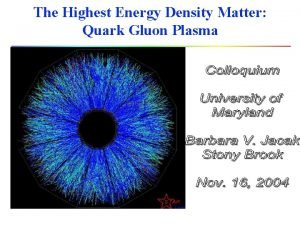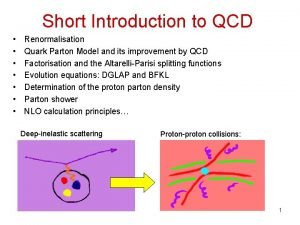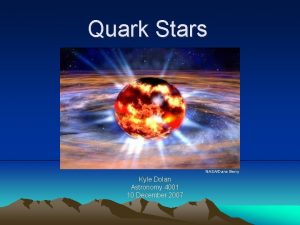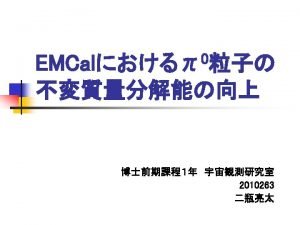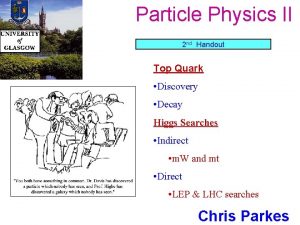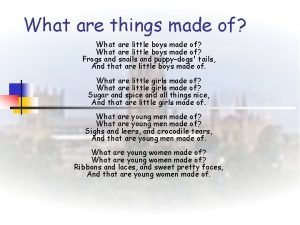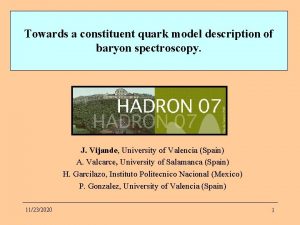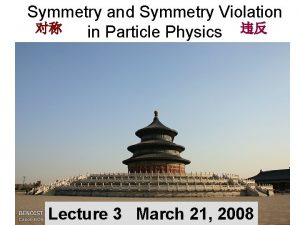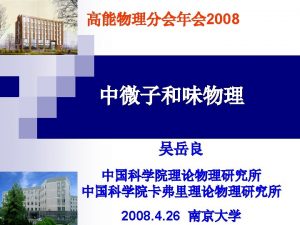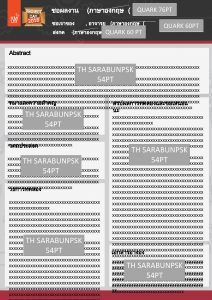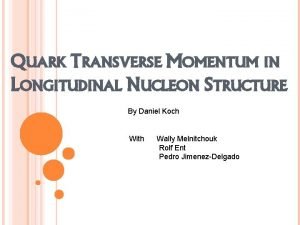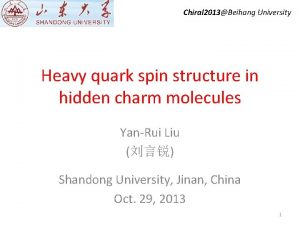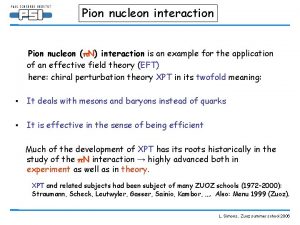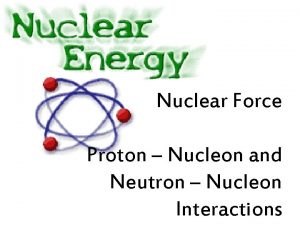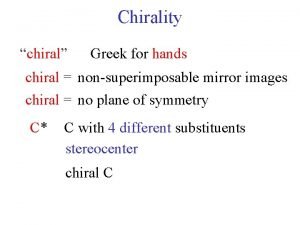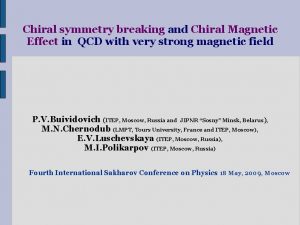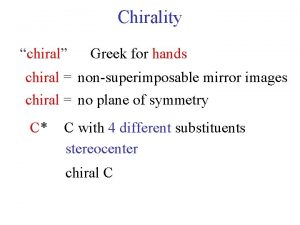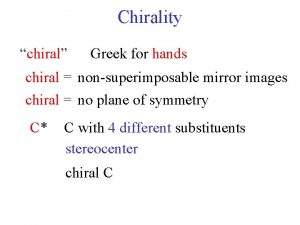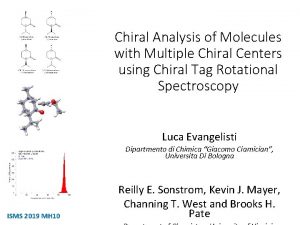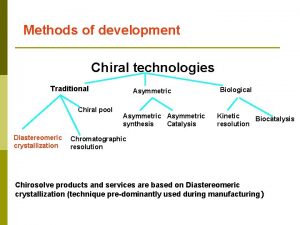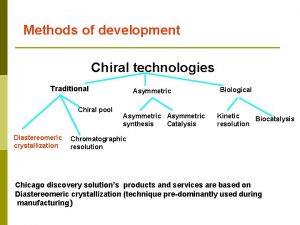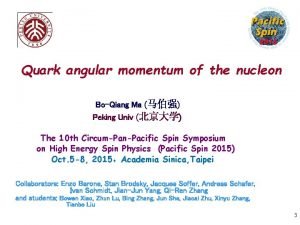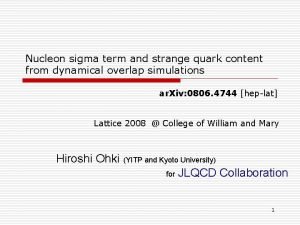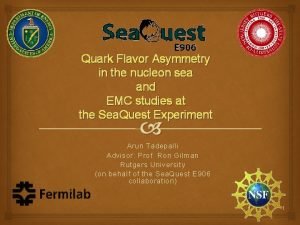Hyperfine Structure of GroundState Nucleon in Chiral Quark





















- Slides: 21

Hyperfine Structure of Ground-State Nucleon in Chiral Quark Model Duojie JIA@Northwest Normal University Collaborated with Rui. Bin Wan, Wen. Bo Dang, Yu. Bin Dong; Thanks for discussions with A. Jarah, J. He, X. Liu Suported partially by NNSF of China (No. 10965005) NNSF of China (No. 11265014) The 7 th International Symposium on Chiral Symmetry in Hadrons and Nuclei (Behang Univ. Beijing, Sept. , 27 -30, Oct. 2013 )

Outline n n n Motivation Quark masses in QCD and models Mass role and pion role in models Chromo-magnetic interaction in Ch. QM Hyperfine splitting of nucleon spectrums Summary

Motivation In explaining neclear force and hadron structures, QCD is still challenging due to its complex nonpertubative nature: (1)gluon/quark condensate vacuum (2)absence of confining dimension (by itself) (3)Complicated phases n Condensate QCD vacuum QCD is very different at long and short distances ( < ΛQCD): q Condensing or melting, depending the scale(momentum) at which you see it! Condensate Inhomogeneo us at short distance Homogeneous at long distance

Motivation QCD(continuum): Nontrivial vacuum, Lack of unified degrees of freedom at long and short distances(< ΛQCD) ; Few parameters : masses) ; g (quark-gluon coupling) : running; μ (energy scale ) mi(current Hard to model the hadrons Besides Lattice QCD, Ch. PT, with appro. global symmetry (Ch. Symmetry) of QCD, and spontaneously broken, gives the pion -octet pseudoscalar(pseudo-Nambu. Goldstone), a Chiral Lagrangian (pion octet +other SU(3)V hadron multiplets ) • Compute hadron observables at low E • fix the light quark masses by extraploting Lattice QCD 4

u Motivation d First-principle QCD(Lattice): The parameters : mi(current masses) ; g (quark-gluon coupling) : running a (the lattice spacing ) What does a quark mass mean when free quarks don’t exist? adjust the bare quark masses in doing a lattice calculation to match physical hadron properties. For the continuum limit, the bare quark masses flow along the renormalization group, ---- extract a renormalized quark mass (asymptotic freedom + a renormalization scheme). In real world, isospin broken by the non-degeneracy of u and d, and by electromagnetism, both comparable order to the hadron spectrumts: -The light quark masses, important parameter for hadron physics and nuclear physics, -is of interest to determine them , and to see their effects 5

Quark masses in QCD and models Lattice prediciton: mud=3. 5 Me. V, ms=95 Me. V [Budapest–Marseille–Wuppertal Collaboration / PLB 701 (2011) 265– 268] The precision below 2% level; ms/mud = 27. 53(20)(08), which is scheme independent( better than 1%).

Quark masses in QCD and models Quark models use the concept of constituent mass, not well-defined in QCD, modeldependent. It used in Chiral quark model(Ch. QM). [A. Manohar, H. Georgi, NPB 234(1984)189] may come from chiral rotation [P. Simic, PRL. 55, 40 --43 1985] Quark mass varys, depending on models n n For nonrelativistic QM(NRp), mu=md=0. 2 -0. 3, ms=0. 5 Ge. V For RQM, quite smaller, e. g. PCh. QM, mu=md=7 Me. V, ms=175 Me. V bag model : mu=md~ 0, ms=300 Me. V

Quark masses in bag models In the bag model, With degrees of freedom (quark, gluon): Masses: mud=0; ms=0. 3 Ge. V

Mass role and pion role in models The pion(NG particles) enters as requiring local Ch. Symmetry In the effective field theory of Quark-meson ----Chiral rotation Diag-gluon Quark current

Constituent Mass(soft mass), corresponding to CS breaking. Why QM works? Gluons Constitiuent quark n Mahohar-Georgi model in Ch. QT: n 2 scales occurs(2 phases) (250 Me. V)ΛQCD< Q < Λχ (1 Ge. V), Confining Mixing Free Strong coupling (α s) weak due to the presence of constituent mass M invarinat under chiral SU(3) L×SU(3)R Non-renormalizable terms suppressed by 10

Quark mass role in Baryons The simplest fit for baryon masses: 1 -4% mu=363 ms=583 The NRp estimate for baryon masses: [PRD 12(1975)147] mu=300 m. P=336 Smaller Fine fit, so why RQM? (1) More constraints on models(including Ch. Symmetry) (2) Less parameters for spin-interaction 11

Quark mass in bag pictures n m 0 The MIT bag-RQM, degrees (quark and/or gluons), Confinement put in by Bag boundary condition/effective mass Mass scale 2 -5 Me. V 300 Me. V The consititent mass(~ 1/R) mainly from BC while the current mass contributes a few Me. V: A mechanism for mass splitting 12

Mass splitting in bag pictures n The MIT bag prediction with chromoelectric and magnetic interation: Allowed mass splitting for nucleons: 1) Kinetic energy splitting mud=0 2) 3) i=u, d, s 4) 2) Chromo-magnetic splitting (i, j=u, d, s) Data: Δmud=2. 5 Me. V, Δmsu=100 Me. V When mq changes so do the kinetic and chromo-magnetic energies slightly. Reasonable except for pion 13

Mass role in Ch. QM n n The consti. mass varying Δmi and the EM effects breaks the flavor SU(3) mainly; The mass varying dominates for p-n spliting, in ground states a=0. 3/0. 2; L=0. 75/0. 2; M=0. 3; S 0=0; kappa=-1; d=1. 0; alpha 0=0. 8; Vc 14

Chromo-magnetic interaction in Ch. QM The plot of effective mass for n The chromo-magnetic interaction is similar to that of bag models The mass-term [mi+S(r)U 5] contributes to (1) Confinement through the S-potential (2) Quark wavefuntion and pion configurations (3) Magnetic moment via quark magnetic moment; (4) Hadron mass and its splitting 0. 0740 15

Chromo-magnetic interaction in Ch. QM n The radial Eq. of Motion of a quark: With Y determined by Y equations The Y profile determined by a dynamics, eg. , the Coupled Skyme lagrangian here, it can be set by comparing with Ch. PT 16

Quark configuration in Ch. QM Length scale L=3. 75 Ge. V-1

Chromo-magnetic interaction in Ch. QM D. Jia, L. Yu, R. Wan, ar. Xiv: 1308. 0700 v 1

Hyperfine splitting in nucleon masses ⊿m (Me. V) u/d mass 0. 360 300/302. 5 0. 723 300/305. 0 1. 011 300/307. 0 1. 293 300/309. 0 1. 436 300/310. 0 1. 723 300/312. 0 19

Hyperfine splitting in nucleon masses n n The CSB explained by NJL model, with quark pair condensation The lator is fixed by the gap equation ΔM=Mn-Mp (Me. V) mu=300 md (Me. V) 309=md 20

Summary • The hyperfine structure of ground-state nucleon is studied in chiral quark model with nonlinear pion interaction in which quarks move in the potential of Coulomb-like plus linear form. • The mass splitting of ground-state nucleon is given by taking into account the colour magnetic interaction between quarks and found to be in agreement with data. • The connection of the model with the bag models is discussed n Thanks !!! 21
 Coupling constant
Coupling constant Nucleon
Nucleon Couche electronique
Couche electronique Nucleon
Nucleon Name of symbol
Name of symbol Nucleon
Nucleon Nucleon
Nucleon Nucleon
Nucleon Determine chiral centers
Determine chiral centers Particle wordle
Particle wordle Color quarks
Color quarks Quark names
Quark names Quark model
Quark model Quark gluon plasma
Quark gluon plasma Quark gluon
Quark gluon Quark parton model
Quark parton model Quark astronomy
Quark astronomy Quark gluon plasma
Quark gluon plasma Top quark decay
Top quark decay Quark names
Quark names Constituent quark model
Constituent quark model A charm quark has a charge of approximately
A charm quark has a charge of approximately
